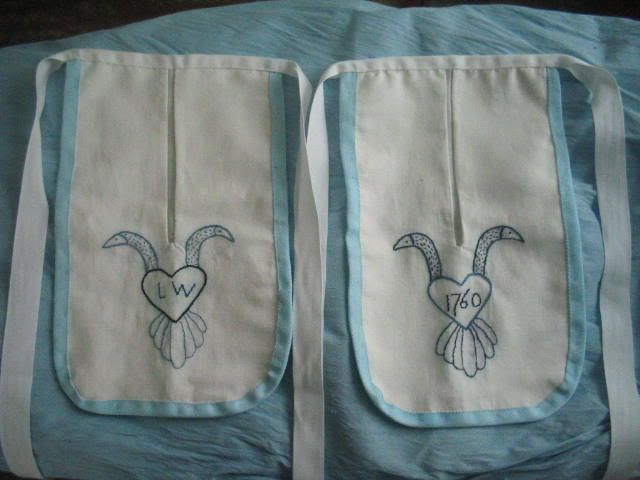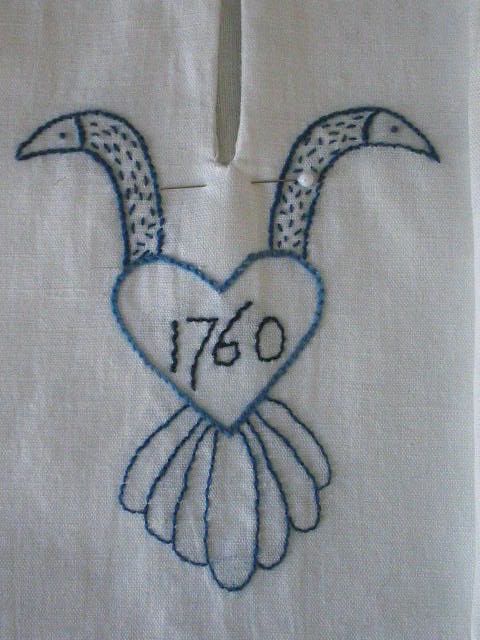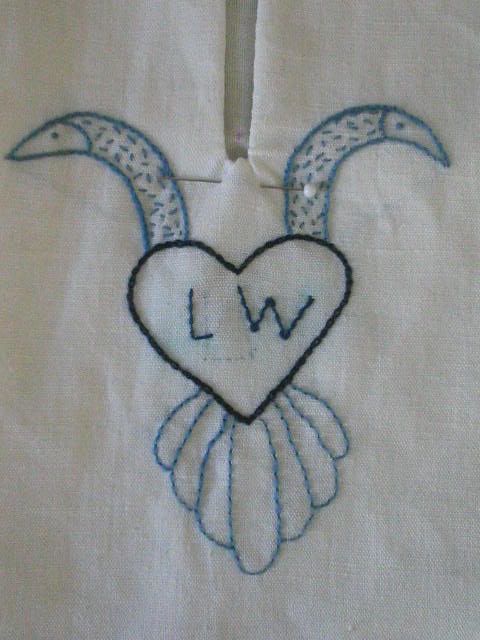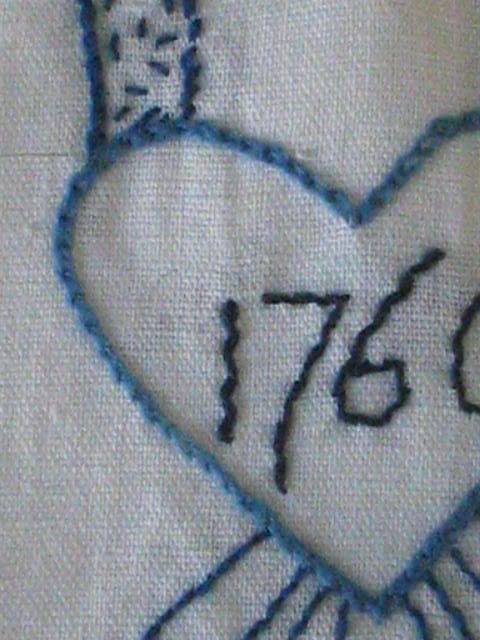In lieu of a complete tutorial on the construction of deathshead buttons I give you, my faithful readers, this photo collage of the process and a few interesting observations regarding the buttons themselves.
In researching for this article, I had a difficult time finding many references to "deathshead" buttons. It was only by a happy accident that I learned why. The proper 18th Century term seems to have been death head, two separate words with no "S" in-between. These buttons could also be called by any number of other names; thread buttons and mohair turning up the most frequently. In fact, thread & mohair turn up in reference to this style of button noticeably more often than death head does.
The
Virginia Runaways Archive lists only two matches for the term death head button. One of the advertisements is for a Scotch servant man who had on when he went away "a cloth coloured frieze coat with white metal death head buttons". Clearly these metal buttons are not the same as the thread covered buttons we commonly associate with the term. I would speculate that the design on the button itself matched the cross design on thread “death head” buttons even though the material itself was different.
When we then turn to
The Proceedings of the Old Bailey for reference to death head buttons, we find only one listing; the case of Mr.s Robert Roberts and Willaim Blann. These two gentlemen were put to death for a robbery in Feb of 1785 which included "1 pair of stuff breeches" with "horn buttons put to the waistband, and the flap, and the pockets, and death-head buttons... put to the knees." It seems in this case the death head wasn't only on the buttons, but on the thieves themselves.
If we then use the same archives, yet change the search terms, we find a wealth of additional listings. The Virginia Runaway Archive lists 5 runaways with "mohair buttons" on their clothing between 1752 & 1773. Two of these listings, from 1768 & 1773 respectively, specify the buttons as "Mohair Basket Buttons", perhaps a variation on the wrapping technique commonly employed in the button construction. The Proceedings of the Old Bailey adds 3 instances of mohair button theft and one unlucky highway man by the name of Silas Dowling, who wore a drab colored fustian frock with matching mohair buttons.
To widen the search even further we can look to the Old Bailey for references to thread buttons. Most of the 8 listings specify metallic thread, either gold or silver, leading me to believe these are also thread wrapped over a button mold in the same style as death head or mohair buttons. It is also interesting to note that all the button thefts, both for mohair & thread buttons, are for large quantities, usually several gross at a time. Although few can rival the grand larceny charge against Patrick Cockhall, who went before the Judge in January of 1782 on charges of stealing 3420 dozen of thread buttons valued at 22 l. 16 s. Mr. Cockhall was fortunate though. As an "old offender" he was only sentenced to hard labor, 2 years in raising sand and gravel upon the river.
According to
A Tour Through the Whole Island of Great Britain, by Daniel Defoe, Macclesfield & Congleton were well known in the mid 18th century as having "thriving manufacture(s) of mohair buttons". However,
The American Museum, or, Universal Magazine of 1789 by Mr. Mathew Carey, suggests that in absence of foreign manufacture, which by this time includes Britain, we should turn to items made at home. It is "therefore to be hoped that the expenfive article of foreign buttons will be omitted in making up our winter clothes". It is further suggested that "Inflead of the silk twift button, called death head, a button covered with cloth, or a firm taffety, of the colour, would be neat, modeft and genteel".
Of course, one could also become too modest & genteel and risk being called a "mohair" by the local thugs. A mohair, according to Captain Grose's 1796 edition of
A Classical Dictionary of the Vulgar Tongue, is "A man in the civil line, a townsman, or tradesman: a military term, from the mohair buttons worn by persons of those descriptions, or any others not in the army, the buttons of military men being always of metal: this is generally used as a term of contempt, meaning a bourgeois, tradesman, or mechanic."
Perhaps that silk ditto suit covered from head to toe with matching 8 sectioned silk polychrome death head buttons is a little too much after all.
~~~
Works Cited:
Fuss, Norman H. 2005. "Death Head" Buttons, Their Use and Construction. Williamsburg, Virginia. Burnley & Trowbridge Company.
Wooded Hamlet Designs "Instructions for Making the Deathshead Thread Button". http://www.woodedhamlet.com/howto_advice/deathshead_instruc.htm (accessed March 21, 2009)
Virginia Runaways “Runaway Slave Advertisements from 18th-century Virginia newspapers”. http://etext.lib.virginia.edu/subjects/runaways/search.html (accessed March 21, 2009).
Proceedings of the Old Bailey "London's Central Court from 1674-1913". http://www.oldbaileyonline.org/ (accessed March 21, 2009)
Defoe, Daniel. 1748. A tour through the whole island of Great Britain: Divided into circuits or journeys. S. Birt and T. Osborne.
Carey, Mathew. 1789. The American museum, or, Repository of ancient and modern fugitive pieces [afterw.] The American museum, or, Universal magazine.
Grose, Francis. 1796. A classical dictionary of the vulgar tongue. Hooper and Wigstead.
Labels: Accoutrements, Tutorials
 Or making a pair of embroidered pockets for a young girl.
Or making a pair of embroidered pockets for a young girl. The pockets themselves are made from 5oz linen, found in my scrap basket and dutch linen tape from Wm. Booth, Draper. The body binding was dyed using just a pinch of "baby blue" fiber reactive dye. Not a period choice, but what I had on hand and needed to use up anyway. Since my intention is for these pockets to last until L is a young woman I constructed them on 2 separate lengths of tape. This way they can tie both in the front & back, allowing the waistband to grow as she does.
The pockets themselves are made from 5oz linen, found in my scrap basket and dutch linen tape from Wm. Booth, Draper. The body binding was dyed using just a pinch of "baby blue" fiber reactive dye. Not a period choice, but what I had on hand and needed to use up anyway. Since my intention is for these pockets to last until L is a young woman I constructed them on 2 separate lengths of tape. This way they can tie both in the front & back, allowing the waistband to grow as she does. The design consists of stem stitch, back stitch, french knots, seed stitch & wrapped running stitch. I varied the colors used but kept the stitches the same in each piece. The finished work is them layered with the working portion of the pocket and bound around the edges. This protects the back of the embroidery & makes the pockets a little more durable. For my readers who have seen just how filthy L gets at events, it's pretty clear why they need the extra layers!
The design consists of stem stitch, back stitch, french knots, seed stitch & wrapped running stitch. I varied the colors used but kept the stitches the same in each piece. The finished work is them layered with the working portion of the pocket and bound around the edges. This protects the back of the embroidery & makes the pockets a little more durable. For my readers who have seen just how filthy L gets at events, it's pretty clear why they need the extra layers! My one complaint is that her initials are so hard to embroider! After several tries I finally had to settle for an only slightly lopsided "W".
My one complaint is that her initials are so hard to embroider! After several tries I finally had to settle for an only slightly lopsided "W".





